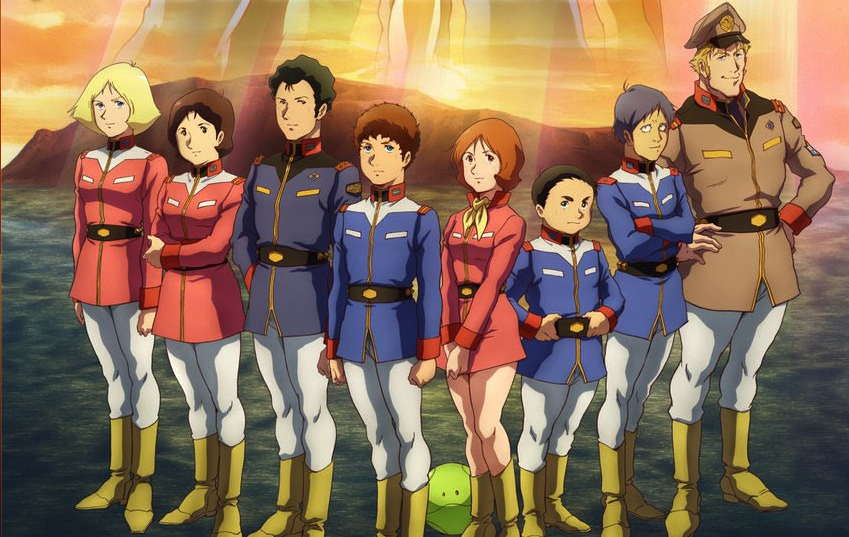[Week 4] Mobile Suit Gundam: Cucuruz Doan's Island (2022 Film)

For the film club I do with friends, I'm picking a series of selections from the Mobile Suit Gundam franchise. Because not all of us are anime buffs, I figured I'd write some short intros for each thing I plan to have us watch, to provide a bit of context and explanation. The intros got a bit longer than I'd anticipated (probably because I was procrastinating working on another thing I should have been working on instead). Since I ended up being really happy with what I wrote, I thought I'd share them with a wider audience here on the blog.
Week 0 | Week 1 | Week 2 | Week 3 | Week 4 | Week 5
This week we move backward to revisit First Gundam, while at the same time skipping thirty years forward for a 2022 film release: Mobile Suit Gundam: Cucuruz Doan’s Island, directed by Yoshikazu Yasuhiko. It’s set sometime during the middle of the One Year War (so, shortly after the the first film but before War in the Pocket), and features the White Base crew–Amuro, Bright, Fraw Bow, and the gang.
Gundam Takes Wing
By 1999, the success of imports like Pokémon, Dragon Ball Z, and Sailor Moon had whetted the American appetite for anime. But despite a few VHS releases, Gundam hadn't much of an impact in the States. That changed in 2000, when the English dub of 1995's "New Mobile Report Gundam Wing" premiered on Toonami, Cartoon Network's anime-focused weekday afternoon programming block.
As a full-on continuity reboot, Gundam Wing was an ideal intro for an audience of Gundam newbietypes. Wing rehashed many of the elements that had made First Gundam a hit in Japan: a focus on "real robot" warfare, a plot exploring political tension between Earth and its colonies, and even a mysterious masked enemy with a secret past. But it also had a hipper and more modern animation style, an appealing multinational team of five Gundam pilots with clashing personalities, and lots of adolescent melodrama and angst.
Wing was a massive hit, and one of Cartoon Network's biggest shows during its run. While only a modest success in Japan, it left a cultural footprint in America unmatched by other Gundam series before or since. On the fanfic site Archive of our Own, the "Gundam Wing" tag is roughly ten times more popular than the tag for any other Gundam series.
All of this is meant only as historical background for Gundam's arrival in America, I won't be having us watch Gundam Wing. But I insist that you watch the final moment of the series premiere. The setup is that Gundam pilot Heero Yuy has enrolled at a ritzy private school to keep tabs on the daughter of an important leader in the enemy faction. Note how expertly Heero maintains his cover and hides his true motives.
[hold for applause]
Anyhow, with American audiences newly interested in Gundam, Bandai finally produced a dub of First Gundam for Cartoon Network in 2001. It wasn't a hit, perhaps due to its dated animation style, and its run was disrupted when Cartoon Network stopped airing content with violent warfare themes in the immediate aftermath of the September 11th attacks. It wasn't until the following year that the full 42-episode English language run would air.
"Wait!" you may protest. "42 episodes? But the original Mobile Suit Gundam had 43 episodes! That's an entire episode less!"
Anime Enemy
If you visit your local all-American mom and pop DVD and Blu-ray store to buy the box set of First Gundam, you’ll still only find 42 episodes included in any American release of the show. That's because during the dub's production, Gundam creator Yoshiyuki Tomino intervened to request that the fifteenth episode, “Cucuruz Doan’s Island”, not be dubbed or included in any international release of the show. (Yes, that's also the name of the movie we are watching!)
There's no official explanation for this decision. At an anime convention in 2002, Tomino remarked: "I asked that it be skipped. There’s a reason, but since the staff is still alive, I can’t talk about it." Cryptic. But if you watch the episode, there's little mystery about the reason: the animation is pretty bad. I’m not going to sit here and tell you that every frame of the other 42 episodes is a masterpiece, but generally I think the show looks pretty cool, especially the mobile suits. In a mecha anime, you want the robots to look good.
However, during the production of First Gundam, animation director Yoshikazu Yasuhiko was hospitalized with a serious lung infection. (Yes, that's also the name of the guy who made the movie we are watching!) In Yasuhiko's absence, episode 15 was outsourced to a different studio, Anime Friend. The results were not up to the show's standards, and may well have ended their Anime Friendship with Tomino and Yasuhiko. Among other off-model oddities, episode 15 gave us the Skinny Zaku, an abnormally svelte rendering of the Principality of Zeon's iconic big beefy green boy, and the infamous Ugly Gundam, a weirdly bloated version of Amuro's iconic RX-78-2 Gundam.
In terms of the plot, it's a fine episode, but it's also a standalone story with little relevance to the ongoing war plot, so its omission is not particularly disruptive to the story. Considering that, and given the problems with the episode, it makes sense that Tomino would prefer its exclusion.
The Origin of the Origin
Yasuhiko recovered from his pleurisy, and returned to work on First Gundam and other Gundam projects. But his true passion was manga, not anime, so he changed careers in the 1980s. Yasuhiko saw great success as a manga artist and writer, particularly for his works of historical fiction and biography, like "My Name Is Nero" and "Rainbow-Colored Trotsky". Fans of his manga know him as "Yas", which is how he signs his artwork.
In 2001, Yas began serialization of “Mobile Suit Gundam: The Origin”, a new manga adaptation of First Gundam. Yas hoped his project would remind readers of Gundam's core antiwar message, and correct some of the "distortions" resulting from the franchise's increasing focus on Newtypes in subsequent installments. In particular, Yas shared Tomino’s feeling of responsibility for Aum Shinrikyo’s chemical attacks. In a 2020 interview, Yas opined that, considering that Aum was "dangerously cozy with the [otaku] subculture", he believed that Aum’s members were “undoubtedly familiar with the concept of Newtype."
Mobile Suit Gundam: The Origin ran for 24 volumes over 10 years, concluding in 2011. The series has been praised for taking a faithful approach to the series while increasing the focus on characterization. Readers praised Yas's most major addition to the story: an extended 2-volume flashback sequence, expanding on the backstory for antagonist Char Aznable and his estranged sister Sayla Mass. Fans and critics also appreciate Yas's take on Amuro, which brought his aggressive and obstinate personality to the foreground, and created more of a consistent throughline in his character development compared to the episodic "resets" of the weekly television format.
While overall a faithful retelling of the show, Yas's manga did skip some events. One such exclusion was Amuro's encounter with Cucuruz Doan, on his titular Island.
Mobile Suit Gundam: Cucuruz Doan's Island
After completing the manga series, Yas made his return to the field of animation to direct a series of six OVAs, also entitled “Mobile Suit Gundam: The Origin”. These OVAs adapted Yas's Char and Sayla flashbacks, which hadn't previously been animated. The OVAs were a hit, and following their conclusion, Yas and several others from that production team began a new project: Mobile Suit Gundam: Cucuruz Doan’s Island, a theatrical film adapting the “lost” episode from four decades earlier.
Despite the original episode's animation issues, Yas believed in the core ideas of the episode and felt the story had potential. This film is his attempt to realize that potential. It's also a considerable expansion of the story, extending a 25-minute episode into a 108-minute feature.
Amazingly, despite the 43 year gap between the episode and the film, some of the original Japanese voice cast reprise their roles. Shuichi Ikeda returns as Char, but stans of the infamous Red Comet should temper their expectations, I think it's just a cameo. Most notably, Tōru Furuya stars as Amuro once again. I’ll be curious to see whether Furuya, now 68, can still sound like a teen, and I'll also be curious to see whether Amuro makes a different sort of impression based on Yas's acclaimed reinterpretation of the character from the Origin manga.
The film is 108 minutes long and you can watch it, dubbed or subtitled, on Crunchyroll Premium here. They offer a free 14 day trial, which will cover you for next week’s viewing as well. We’ll talk at 9.
This is a weird movie! I'm not sure this storyline supports this long of a run time. One of my favorite things about this movie is that it briefly puts Amuro, a character who is defined by his supernaturally intuitive grasp of mechanical and farming skills, into a context where those skills are not valued. There is an incredibly "Amuro does not know how to do farming" scene which I wish was the focus of the whole movie. I thought it was enjoyable but not exactly a franchise high point. Our movie club was split pretty much the same way, in terms of who was positive and who was negative on it. I'm kind of curious how folks are going to react to next week's entry which is definitely the "most different" of our selections.
Next: [Week 5] Mobile Suit Gundam: The Witch From Mercury (2022 TV Series)

Member discussion